Chainsaws are perfect for felling trees, pruning branches, and cutting up logs. They’re also great for removing stumps.
How do you choose the best chainsaw? There are several factors to consider, including the size of the engine, the mobility of the machine, and the weight of the saw. You need to decide what type of fuel the saw uses. Gasoline-powered saws are the most powerful, but they also require the most maintenance. Electric models with a power cord and battery-powered cordless models (with a rechargeable battery) are the lightest and most user-friendly, but they may not be powerful enough for some jobs.
There is no one-size-fits-all answer to the question of which type of chainsaw is right for the job. That said, here are some general tips on choosing the right chainsaw for the job:
–Choose a chainsaw with the right guide bar length. The bar length is the distance between the end of the chain (cutting tip) and where the chain enters the engine housing near the saw handle. It’s important to choose a chainsaw with a bar length that is long enough to cut through the size of wood–tree or branch–you’re cutting.
–Choose a chainsaw with the power you need. The engine size will determine the power the chainsaw has. It’s important to choose a chainsaw with enough power to cut through the wood you’re cutting.
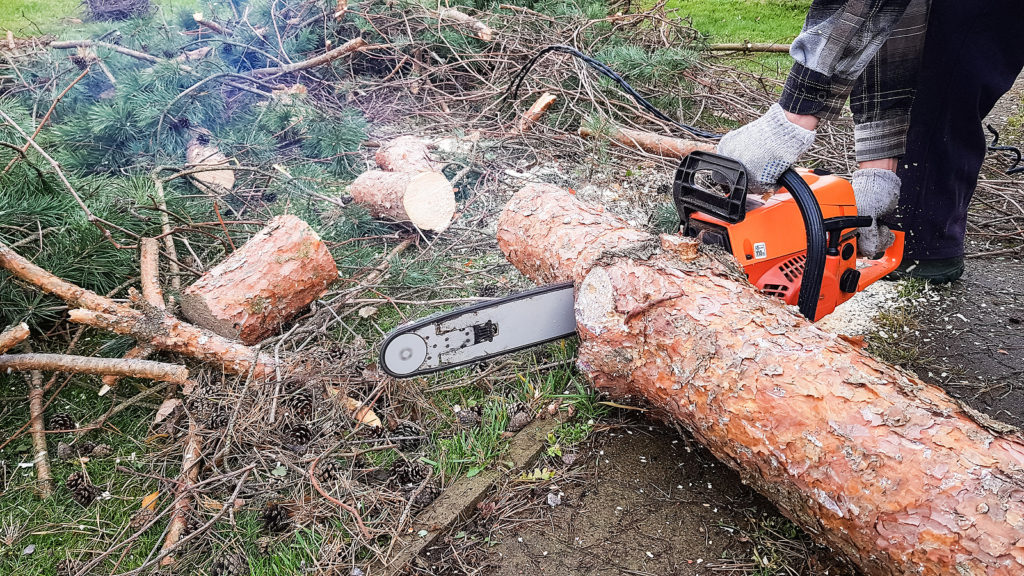
What are chainsaws used for?
- Use a chainsaw to take down a whole tree.
- Use a chainsaw to prune or remove branches more than 2 to 3 inches in diameter.
- Use a chainsaw to cut up logs for firewood.
Basic chainsaw things to know
- A chainsaw is a gas-powered, electric-powered (corded), or battery-powered (cordless) saw with a long blade called a guide bar surrounded by a continuous chain that revolves around its edge.
- The engine of a chainsaw is called the power head.
- The power head powers a cutting chain with numerous sharp teeth. The chain is driven by a centrifugal clutch. The chain moves around a groove in the guide bar. The sharp teeth on the chain cut the surface of the wood.
- Gasoline-powered chainsaws tend to be heavier duty and are available in a wide range of sizes and capabilities, from those for home use to professional logging operations.
- Gas engines are rated by displacement (measured in cubic inches running from about 1.6 to an enormous 8.3), with the higher numbers indicating more power.
- Corded electric-powered chainsaws are powered by electric motors. They are easy to start, quiet, do not use volatile fuels, and emit no exhaust fume.
- Cordless battery-powered chainsaws are powered by rechargeable batteries. They also are easy to start, quiet, do not use volatile fuels, and emit no exhaust fume.
- Chainsaws have four types of teeth: chipper (most common), chisel (typical on professional models), semi-chisel (a good combination of chipper and chisel), and automatic sharpening (for specially equipped saws).
- Replacement guide bars and new chains are available.
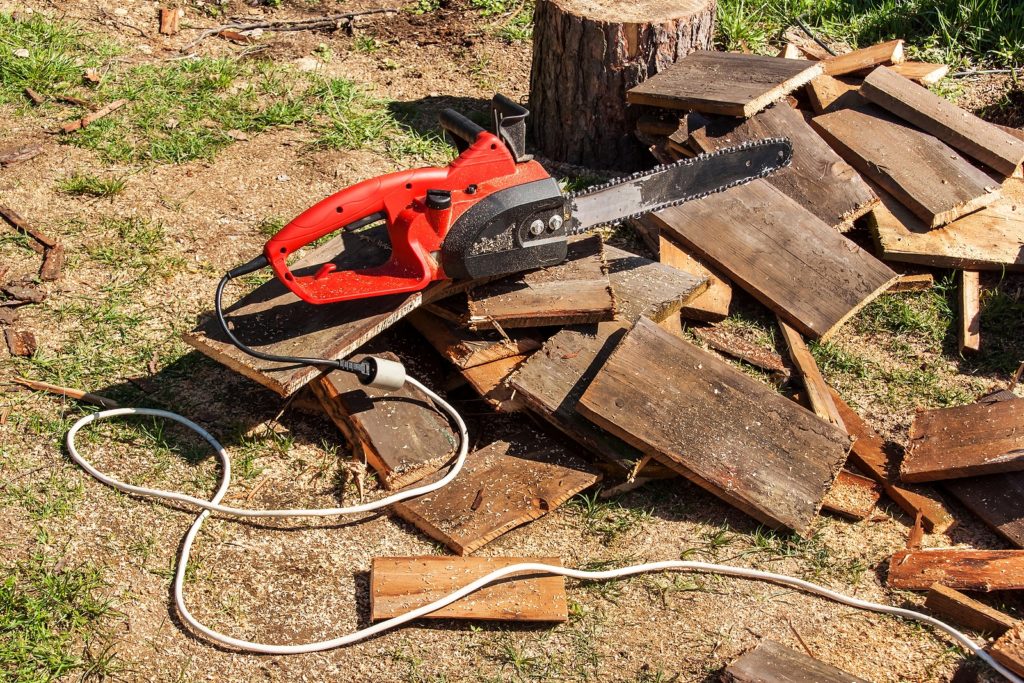
Types of chainsaw
Electric corded chainsaws
Electric corded chainsaws run on electricity. They require an extension cord and must be plugged into an electrical outlet. Corded chainsaws are lightweight and best suited for cutting small limbs or logs, pruning small trees, and cutting small branches.
- Pros: less expensive, lightest weight, no fuel, not necessary to re-charge batteries, easy to start, quieter, no fumes, less maintenance, can be used indoors.
- Cons: slower cutting speed, requires outlet and extension cord, range limited by the length of extension cord, potential electric shock, shorter bar length, no chain brake, manual bar oiler, limited grip top handles.
- Tip: follow the device manufacturer’s instructions for selecting a compatible extension cord (usually a 14-gauge or heavier 12-gauge extension). Extension cords usually max out around 100 feet.
- Cost: average $40 to $300.
Cordless battery-powered chainsaws
Cordless battery-powered chainsaws are powered by rechargeable batteries. The batteries require a charging station that is plugged into an electrical outlet. Battery-powered chainsaws can handle a range of cutting tasks; they are limited only by the guide bar/chain length and battery voltage and life.
- Pros: good mobility, less vibration than gas models, the motor does not produce emissions; brushless motors and high-voltage batteries give long-lasting power, and batteries may be interchangeable with power equipment from the same manufacturer.
- Cons: cost can be about the same as gas saws, run time is determined by the voltage and amp-hour rating of the battery (about 30 to 40 minutes of semi-continuous cutting on a single charge), battery re-charge time of about 60 minutes can slow your work.
- Cost: average $180 to $330.
Gas-powered chainsaws
Gas-powered chainsaws are very versatile; they can take on a range of tasks in nearly all places. They range in size from small models for home use to large professional models. They are the least environmentally friendly; they burn gas and oil and emit fumes.
- Pros: best for heavier work, faster, smooth cutting, big range of sizes and cutting capacities to choose from, work anywhere, more safety features.
- Cons: usually more expensive, needs fuel/oil mixtures, stepped starting procedure, heavier and noisier than battery or electric models and creates fumes, requires more maintenance.
- Cost: Average cost $140 to $500.
Pole chainsaws (gas, corded, cordless)
- A pole chainsaw is a small power saw mounted on an extension pole.
- Pole chainsaws are available in gasoline-powered, cordless (battery), and electric corded models.
- The handle can be lengthened by attaching a solid extension piece or with telescopic poles.
- Some come with interchangeable attachments.
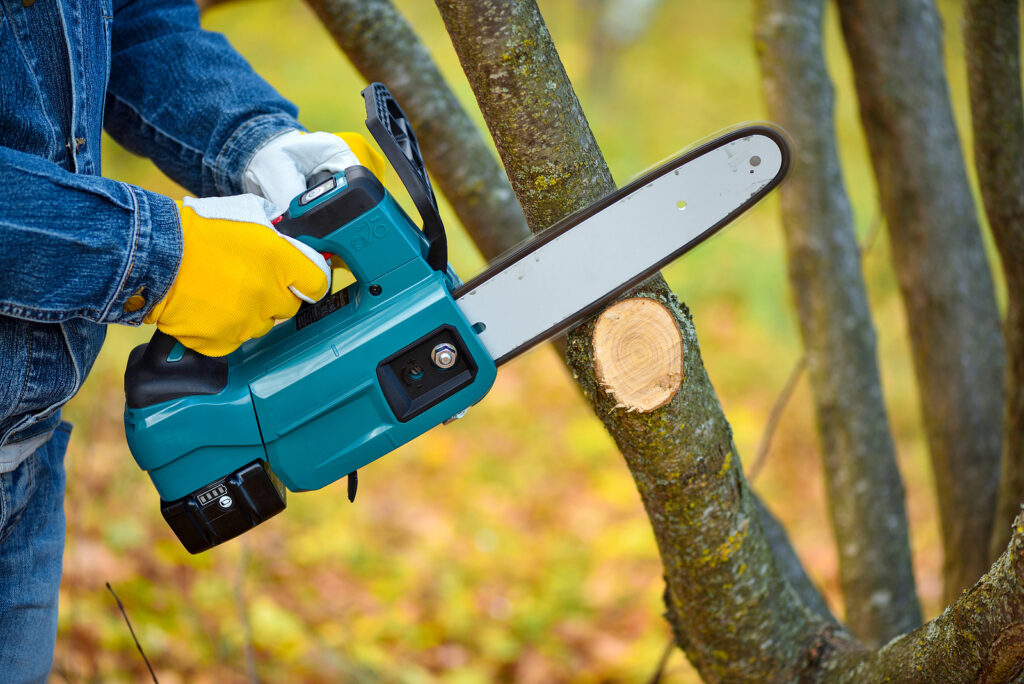
Questions to consider when buying a chainsaw
- What is the primary use of the chainsaw? Pruning tree branches? Cutting firewood or thick logs? Felling trees? A saw with a longer bar can cut larger-diameter wood in a single pass.
- What kind of wood will you be cutting? Oak and maple are hardwoods and require more power.
- How often will you use the chainsaw?
- Can you store gasoline and bar oil for a gas-powered engine?
- What does the saw weigh? The longer the bar and the bigger the motor or engine, the more the machine will weigh. Consider the weight you can handle from 15 minutes to an hour.
- How does it handle? Does it feel comfortable and balanced in your hands? The larger the machine the more effort it will take to handle. A smaller, less powerful saw will be more manageable.
- Have you considered a corded-electric or a battery-operated chainsaw? These can be used for cutting small trees, pruning, and trimming.
Engine size
When choosing a chainsaw it is important to match the size of the engine and the length of the guide bar to the job to be done. The larger the chainsaw the more energy or gas it will use. The larger the chainsaw the more it will weigh.
- The engine on a chainsaw is called the power head. The cutting system on a chainsaw consists of a chain and guide bar. Powerheads come in several sizes and bars come in several lengths. Manufacturers usually match the guide bar length to the power capability of the power head.
- The engine size of a battery chainsaw is described in terms of voltage.
- The engine of corded models is described in amperage and horsepower. A typical homeowner’s electric chainsaw will have from one to three horsepower.
- The engine size of a gas-powered chainsaw can be measured in horsepower or engine displacement in cubic inches (ci) or centimeters (cc) which denotes engine displacement. The bigger the saw’s engine the more power it will have and the quicker it will cut.
- The higher the number–engine displacement, voltage, amperage, and horsepower–the more power the saw has.
- As a general rule, corded electric and battery-powered chainsaws have less power than gas chainsaws.
Bar length
- Choose a bar length that can get the cutting job done. Bar length is usually matched to the engine size and power.
- Bar length is measured from the cutting tip to where the chain enters the engine housing.
- Homeowner bar lengths ate commonly 14″, 16″, 18″, and 20″. There are bars as short as 8″.
- Pro bar lengths are 20″ or more.
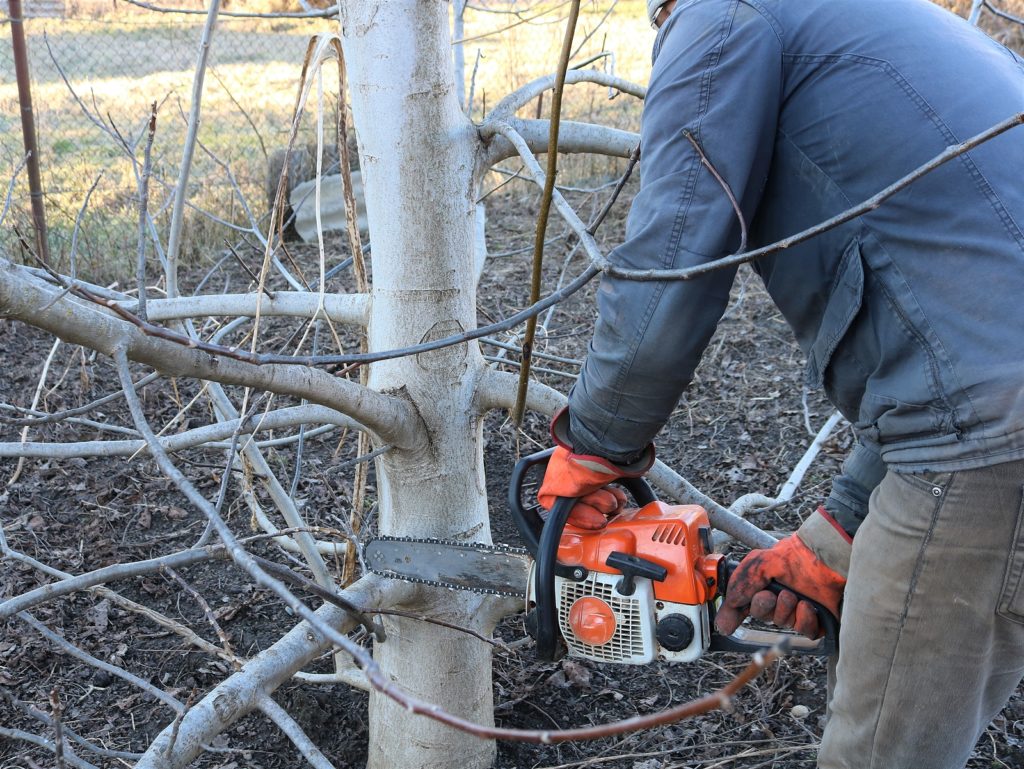
Task and recommended engine size
Here are common chainsaw tasks matched to the engine size you will need:
- Trimming a hedge or clearing brush: 30cc/small electric
- Pruning tree branches: 30cc/small electric
- Removing tree limbs: 30cc/mid-size electric
- Felling a small tree: 30-40cc/mid to large electric
- Light firewood cutting (under 10 inches diameter): 35-45cc/large electric
- Moderate size tree felling (10″ to 16″ diameter): 45cc+/large gas or pro electric
- Large log cutting (16″ to 24″ diameter): 50cc+ gas engine
Task and recommended guide bar length
Here are common chainsaw tasks matched to the guide bar length you will need:
- Trimming a hedge or clearing brush: not more than 12″-16″
- Pruning trees: 12″ or less
- Limbing: 12″-14″
- Small tree felling: 12″-14″
- Light firewood cutting (under 10″ diameter): 14″-16″
- Moderate size tree felling: 16″-18″
- Medium firewood cutting: 16″-18″
- Large log cutting: 20″+
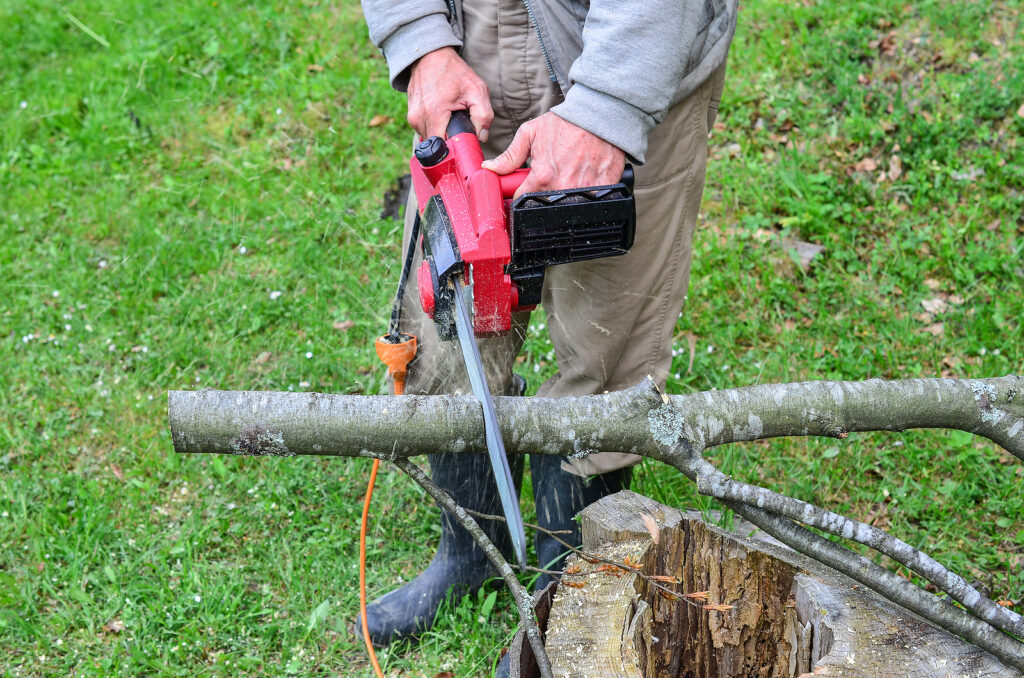
Recommended chainsaw features
Here are several features you may want to look for when choosing a chainsaw:
- Front hand guard: protects the left hand and wrist not on the trigger in the event of kickback. Chainsaws are not manufactured in left-handed configurations.
- Chain brake: stops the chain from moving to help prevent injury; the front guard acts as a brake when it is pushed forward; pulling it back allows the chain to move again.
- Ignition “on/off” switch: on electric saws; turns the electric system on or off.
- Safety throttle: a mechanism that will not allow the trigger to be pulled unless you have a grip on the rear handle; prevent accidental chain acceleration.
- Chain catcher: a protruding bar at the bottom of the saw that will stop the rotation of the chain if it breaks or derails.
- Rear handle guard: this is a widening of the back handle; it is designed to prevent hand injury if the chain breaks or derails.
- Choke: helps start a cold engine; restricts the air supply to the carburetor, making the air mixture rich.
- Spring-assist starting: this reduces the pulling force needed to start a gasoline-powered saw.
- Anit-vibration system: this is a system made up of either rubber bushings or coil springs between the engine and handles; the system reduces numbing vibration on the operator’s hands.
- Muffler and spark arrestor: a muffler will reduce engine noise; a spark arrestor is a screen that keeps sparks that can cause a fire from flying from the machine.
- Automatic oiler: lubricates the chain as you cut so you don’t have to remember to activate it.
- Correct chain/bar combinations: use the chain size recommended for the guide bar; an incorrect combination can result in the chain not fitting the drive sprocket for the saw or the sprocket tip of the guide bar. An incorrect length will not fit on the saw.
- Bar and chain scabbard: protects the bar and chain when the saw is not in use.
- Carrying case: protects the saw and makes it easier and safer to transport.
- Scrench tool (all-in-one tool).
- Chainsaw sharpening kit and chainsaw files.
Chainsaw safety equipment
Personal safety equipment is always recommended when using a chainsaw or other power equipment. These items are highly recommended:
- Eye protection with side shields.
- Hearing protection: earplugs or earmuffs.
- Boots or shoes with steel toes and nonskid soles.
- A hard hat for protection from falling branches.
- Chaps or cut-resistant pants to protect your legs.
- Gloves with enhanced gripping surfaces.
- Chainsaw helmet with face protection, neck guards, and ear protection.
Chainsaw safety
Here are chainsaw running best practices:
- Grip gas-powered chainsaws firmly when pull-starting and keep the saw on the ground.
- Never saw while on a ladder or use the saw above shoulder height.
- Do not saw using the tip of the chain and bar; kickback towards you can occur.
- Keep the chain properly sharpened, tensioned, and oiled to speed cutting and help prevent kickback.
- Be sure the chain is properly tensioned; a loose chain can slip off the bar and spin toward the operator.
- Never run a gasoline-powered tool indoors or in an enclosed space; they produce carbon monoxide, a gas that is potentially fatal.

Chainsaw maintenance
Before using a chainsaw do the following:
- Consult the owner’s manual and follow the manufacturer’s suggestions.
- Check for leaks, cracks, and damage to the machine.
- Test the throttle, choke, trigger lockout, and stop switch.
- Check the chain brake.
- Check the chainsaw chain and the chainsaw bar for damage–bent teeth or a warped bar.
- Be sure the chain is properly aligned on the guide bar and adjust the chain tension as recommended by the manufactuer.
- Check bar, fuel, and oil levels.
- If you are not planning to use the saw for an extended period of time, drain the fuel and oil. Run the engine of a gas-powered chainsaw until the carburetor is dry.
The chain is dull and needs sharpening or replacing if:
- You need to apply pressure to cut into the wood. A sharp saw will pull itself into the wood.
- It smokes even though it is fully lubricated.
- The sawdust is fine instead of strands or large chunks.
- The chainsaw bounces, rattles, or pulls in one direction.
Shopping list
- Chainsaws for branches under 4-inches in diameter
- Corded chainsaws
- Cordless battery chainsaws
- Gas-powered chainsaws
- Pole chainsaws, also called pole saws
More Buyer’s Guides:















